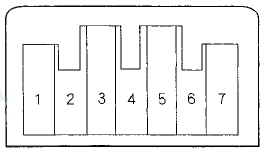 Honda Accord: Recirculation Control Motor Test
Honda Accord: Recirculation Control Motor Test
NOTE: Before testing the motor, check for HVAC DTCs (see page 21-101).
1. Disconnect the 7P connector from the recirculation control motor.

Incorrectly applying power and ground to the recirculation control motor will damage it. Follow the instructions carefully.
2. Connect battery power to terminal No. 1 of the recirculation control motor, and ground terminal No.
2; the recirculation control motor should run, and stop at Fresh. If it doesn't, reverse the connections; the recirculation control motor should run, and stop at Recirculate. When the recirculation control motor stops running, disconnect battery power immediately.
RECIRCULATION CONTROL MOTOR

3. If the recirculation control motor did not run in step 2, remove it, then check the recirculation control linkage and door for smooth movement.
• If the linkage and door move smoothly, replace the recirculation control motor (see page 21-64).
• If the linkage or door sticks or binds, repair them as needed.
• If the recirculation control motor runs smoothly, go to step 4.
4. Measure the resistance between terminals No. 5 and No. 7 of the recirculation control motor. It should be between 4.2 and 7.8 kO.
5. Reconnect the recirculation control motor 7P connector, then turn the ignition switch to ON (II).
6. Using the backprobe set, measure the voltage between terminals No. 3 and No. 7 of the 7P connector.
Fresh: About 1.0 V
Recirculate: About 4.0 V
7. If either the resistance or the voltage readings are not as specified, replace the recirculation control motor (see page 21-64).
 Mode Control Motor Test
Mode Control Motor Test
NOTE: Before testing the motor, check for HVAC DTCs
(see page 21-101).
1. Disconnect the 7P connector from the mode control
motor.
Incorrectly applying power and ground to the mode
control mo ...
 Climate Control Unit
Removal / Installation
Climate Control Unit
Removal / Installation
With Navigation
1. Remove the passenger's dashboard undercover (see
page 20-170).
2. Disconnect the connectors (A). Loosen the bolt (B)
and remove the bolts (C) from the climate control unit (D) ...
See also:
Fog Lights
If equipped
Turn the fog lights on and off by
turning the switch next to the
headlight switch.
You can use the fog lights only when
the headlights are on low beam.
With the light switch in ...
Fuel Line/Quick-Connect Fitting
Precautions
The fuel line/quick-connect fittings (A, B, C, D, E, and F)
connect the fuel rail (G) to the fuel feed hose (H), the fuel
feed hose to the fuel line (I), the fuel line (J) to the fuel
tank unit (K) ...
Driver's Power Seat Motor Test
1. Remove the d r i v e r ' s seat (see page 20-194).
2. Remove t h e p o w e r seat adjustment switch knobs a nd
t h e recline cover f r om t h e seat.
• 4-door (see page 20-234)
• ...
